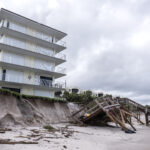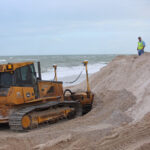Updated at 11:15 a.m.
INDIAN RIVER COUNTY — The brand new sand on north county beaches is being hailed by enthusiasts as the best-quality sand in the county – maybe in all of Florida. However, residents in northern Orchid and Sanderling, as well as beachgoers to Golden Sands Park won’t get any between their toes this summer.
Following a report from contractors that they would only be able to produce 4,200 cubic yards of sand in the final days of the project, a last-minute decision was made to divert all available resources to the Sea Grape Trail area for a final push to complete Baytree and Marbrisa, sparing those beaches from being left bare during the 2010 hurricane season. The decision was made because structures in Marbrisa and Baytree are dangerously close to the dune, only 25 feet away in some places, and the elevation being three feet lower — 15 feet above sea level — as opposed to 18 feet in the Orchid area.
No residential structures are at risk at Golden Sands Park and the Orchid condos have an approximate 125-foot buffer between buildings and the coastal construction line.
Critics feared that due to the trial-and-error nature of the large-scale use of upland sand and unavoidable regulatory red tape, the project might not be completed prior to the start of turtle nesting season on May 1. And that’s what happened.
The replenishment project’s extension ends Friday, but county Coastal Engineer James Gray said crews are scheduled to wrap up delivery of sand by end of day Thursday. Equipment has already been removed from Golden Sands Park and will be off all of the beaches Friday.
When county commissioners voted in September to take a chance on trucked-in upland sand to replenish north county beaches because they were getting a bargain price of $7.3 million, they were confident that permits would be received quickly, and construction would go smoothly.
Weather delays, equipment troubles and the predicted stringent environmental testing caused the project to lag weeks behind, forcing the county to ask for more time. Meanwhile, the price tag – for the sand, testing, dredging, engineering, grating, processing, overtime, design, re-design, reporting, etc. — has ballooned to nearly $15 million, including an anticipated artificial reef the county expects to be required to build in 2013.
When negotiations hit a snag and it looked like crews might either walk off or slow sand mining to a snail’s pace, the county under duress agreed to $3 million in change orders and a $300,000 lump-sum payment to cover expenses which possibly should have been included in the cost of doing business.
May 1 came and went. On April 30, regulators granted an extension, giving contractor Ranger Construction an extra week to get 317,000 cubic yards of sand on the beach.
“To avoid the potential for ‘take’ of sea turtles, the U.S. Fish and Wildlife Service (FWS) limited the request to 7 days,” said County Coastal Engineer James Gray in his weekly update to the Board of County Commissioners.
“Specifically, the FWS evaluated sea turtle nesting data for the project area from 2007 through 2009. Based on this information, the FWS determined that there is a notable increase in sea turtle nesting within the project area beginning in early May.”
Turtles have already been nesting in and around the construction area, and each time an active nest is found by the biologists combing the beach each morning on the pre-construction survey, work is delayed while the nest is cordoned off, documented and moved safely out of the active replenishment zone.
As of Sunday evening, crews had begun working in the area of the Grand Harbor Beach Club via the Sea Grape Trail beach access. Approximately 279,500 cubic yards, or 88 percent of the sand, had been delivered to the beach. That puts Ranger Construction firmly past the 269,000 cubic yard mark, which triggered the $300,000 lump-sum payment for mobilization of a third dredge and other expenses.
“The remaining 1,500 feet of the active construction which includes sections of Golden Sands Park, Sanderling, Orchid, Grand Harbor have not been fully constructed (dune plus berm) to date,” said Gray. The total Phase 1 shoreline is approximately 23,200 feet in length.
Gray reported to commissioners on Tuesday that, as of May 2, 60 percent of the total linear feet in Phase 1 project area has been fully constructed and 67 percent of the total linear feet in Phase 1 project area shoreline has newly placed material.
By Friday – which is the absolute last day of construction – county staff expects Ranger Construction to have fully constructed 86 percent of the linear feet of the project. That will leave about 3,400 feet either without any new sand or with only a smattering of what was expected.
Gray said this orphaned area includes an 800-foot stretch of beach in front of the Orchid Island Golf and Beach Club condominiums.
“The remaining sections will be completed during Phase II this coming November,” Gray told county officials on Tuesday.
That, in fact, will depend upon how the upland sand performs in the rigorous testing scheduled for this summer. The turtle test plan will reveal whether or not turtles reproduce well in the new, trucked-in sand. If regulators give the thumbs up, the second phase can proceed as scheduled after Nov. 1. If not, the county may be forced to go back to the tried and true way of replenishing beaches with dredged, off-shore sand pumped in from a high-quality source about one mile off Round Island Park.
Other areas that did get their full template of sand are mid- to southern Orchid, Summerplace, Wabasso Beach Park, Sea Oaks, Carlton, northern John’s Island and Disney’s Vero Beach Resort – one of the few commercial interests in the replenishment zone, but an entity which lobbied very hard to get the sand project underway.
Wabasso Beach and Turtle Trail have already reopened and Sea Grape Trail is expected to re-open by May 15 at the latest, after equipment is pulled out and the access area is restored to its pre-construction state.
In the next few weeks, workers will be using only light vehicles to plant dune-stabilizing vegetation on the newly completed dunes to help the sand stay in place.






